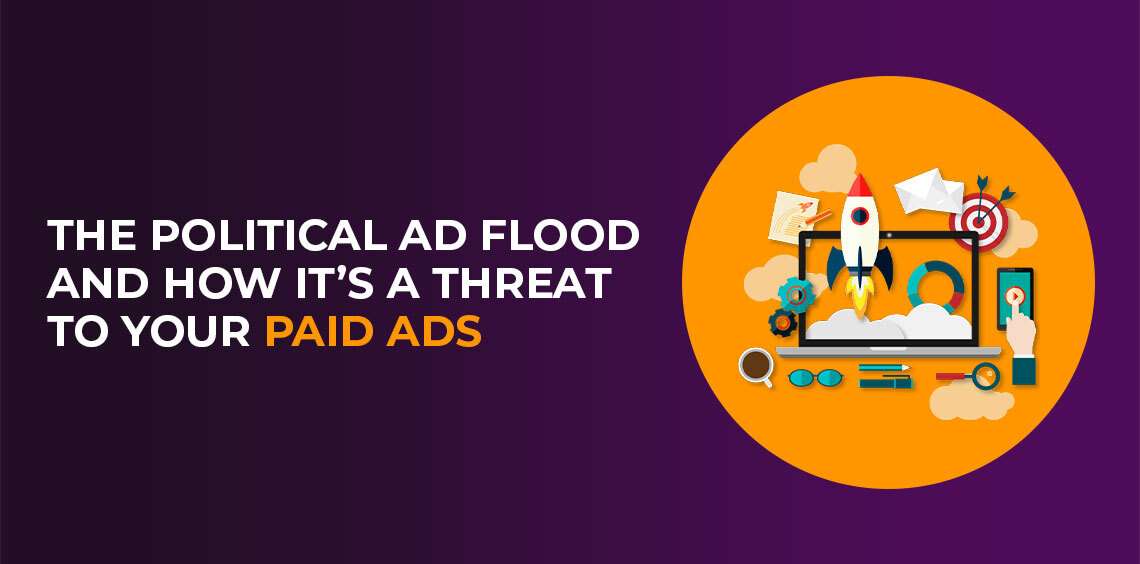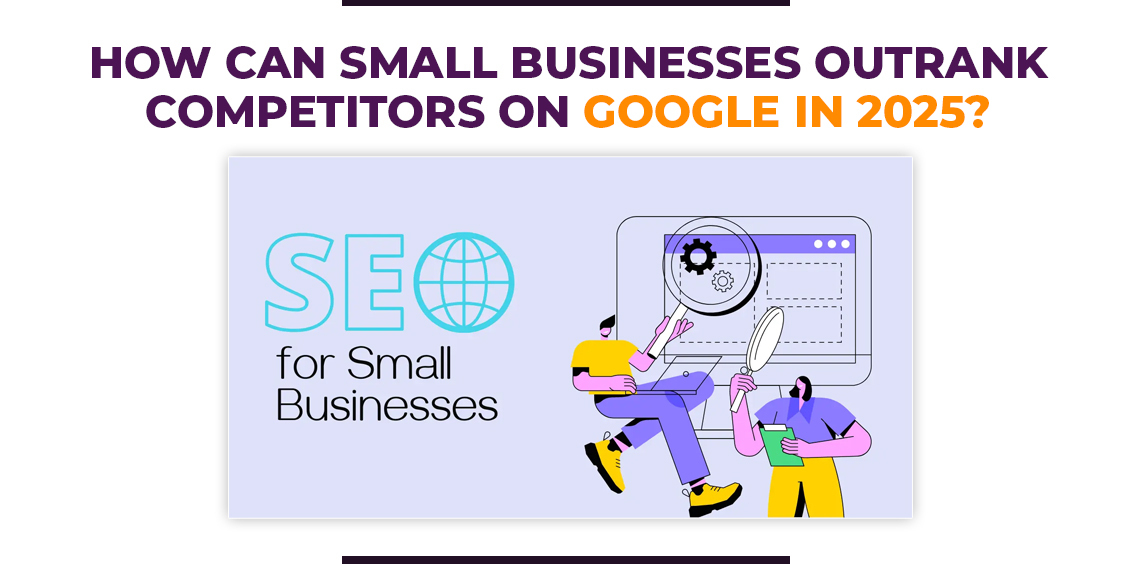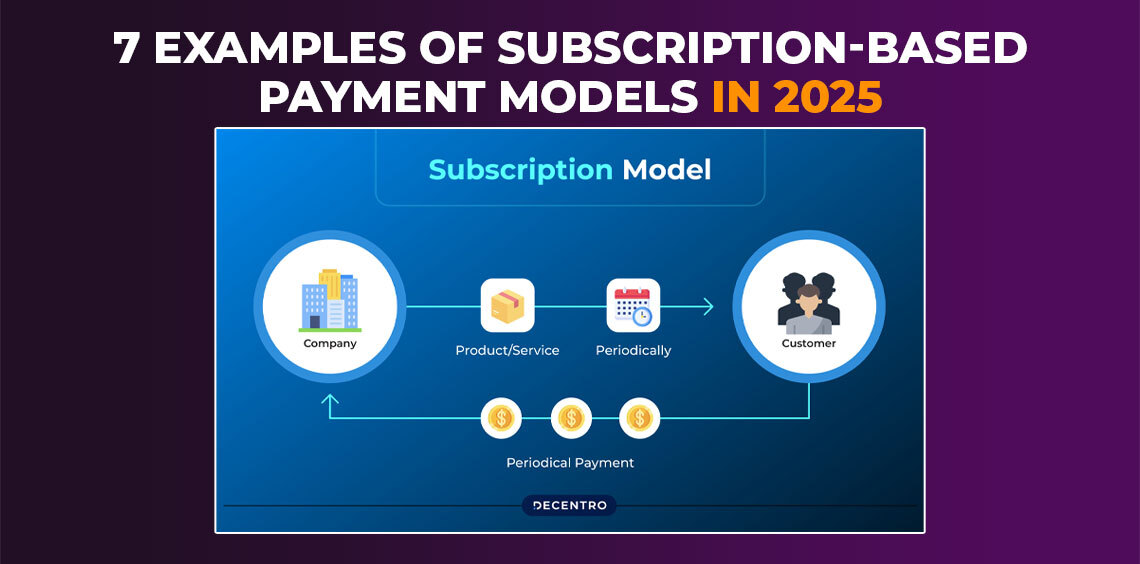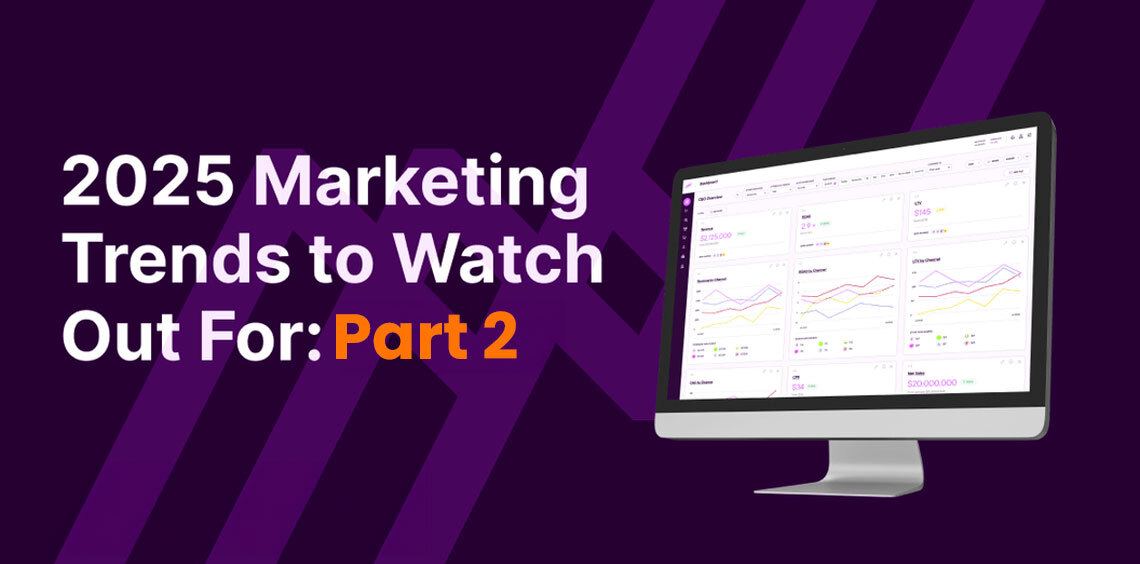Learn how ‘The Political Ad Flood and How It’s a Threat to Your Paid Ads’ impacts costs, visibility, and ad performance during election cycles.
Are you having trouble getting your social media ads noticed as election season heats up? With political campaigns spending billions on advertising, it’s tougher than ever for businesses to stand out. The increase in political advertisements not only raises costs but also drowns out your brand’s message.
The US elections have flooded social media with billions in ad spend, potentially driving up costs for businesses. Political advertising, with its large budgets and few restrictions, takes up a lot of ad space, leaving less room and higher costs for other businesses.
During election season, particularly when it is in full swing, these ads flood TV, digital, print, and radio, making it difficult for regular advertisers to keep up and remain visible. Businesses frequently fail to perform well in paid advertisements because billions of dollars are spent on political ads.
In this article, we’ll explore how the influx of political ads impacts your digital marketing efforts, the challenges of targeting your audience in this crowded space, and effective strategies to protect your marketing budget.
Let us go over what you need to know to navigate this election year and keep your advertising campaigns on track.
Table of Contents
ToggleKey Takeaways
- Political ads flood increase competition and costs for businesses advertising on social media during elections
- Diversifying traffic sources helps reduce dependence on social media advertising during political seasons
- Focusing on organic growth strategies can build sustainable online presence without relying on paid ads
- Re-evaluating targeting strategies can help businesses reach relevant users less affected by political messaging
- Leveraging seasonal opportunities like Black Friday can offset the impact of political ad saturation
- Political Ads, Social Media Platforms, and Microtargeting
- The Evolution of Political Advertising: From TV to Social Media
- The Impact on Commercial Advertisers
- Rising Costs and Competition
- Platforms Dominated by Political Ads
What Is the Political Ad Flood?
During election seasons, political campaigns ramp up their advertising efforts across every available platform, creating what is often referred to as a “political ad flood.” This term describes the overwhelming surge of political ads that saturate digital and traditional media alike, leading to heightened competition for advertising space.
Political ad campaigns are carefully crafted marketing efforts designed to promote candidates, ballot measures, or specific political messages. These ads aim to sway public opinion, mobilize voters, and raise awareness on key issues.
They often combine emotional appeals, targeted messaging, and sometimes even controversial content to create maximum impact. In election cycles, these campaigns become particularly aggressive, as political parties, advocacy groups, and candidates aim to secure their positions by influencing the electorate.
The Evolution of Political Advertising: From TV to Social Media
Political advertising has shifted from traditional media to digital platforms like Facebook and Instagram, with campaigns now spending billions on targeted online ads. This surge, especially during election cycles, directly competes with commercial brands, raising ad costs and lowering visibility for businesses. Research from the 2020 U.S. election highlights the intense competition for digital ad space, leaving many businesses struggling to maintain their usual performance.
Why Do Political Ads Flood Surge During Election Periods?
Political ads surge during election periods due to the urgent need to capture voter attention. Elections are high-stakes events, prompting candidates and political action committees (PACs) to invest heavily in digital outreach as election day approaches.
This spending can reach billions, especially during midterm and presidential campaigns, as social issues and national debates amplify the volume of ads, making them nearly unavoidable.
Political Ads and Microtargeting: A Challenge for Commercial Advertisers
Political ads have dramatically reshaped the digital advertising landscape, with microtargeting becoming one of the most potent tools in election campaigns. Social media platforms like Facebook are central to this transformation, providing political campaigns with the ability to deliver highly tailored messages to specific groups of voters based on their demographics, behaviors, and interests.
While microtargeting offers precision and effectiveness for political candidates, it often comes at the expense of businesses that rely on the same platforms to reach their own audiences.
Relevance to Paid Ads
- Competition for Ad Impressions: Political campaigns utilize microtargeting in the same way as commercial advertisers, often targeting similar user demographics. This overlap increases competition for valuable ad impressions, particularly in niche markets where businesses rely heavily on targeted campaigns to maximize return on investment (ROI). As a result, the influx of political ads pushes up the cost per impression (CPM) and cost per click (CPC), leaving businesses with fewer opportunities to reach their intended audiences at the same price.
- Escalating Costs: In the lead-up to the 2020 U.S. election, political advertisers paid a premium for Facebook’s highly targeted ad space. Small and medium-sized businesses that rely on microtargeting were priced out of the market as political advertising budgets increased. This shift disrupted paid advertising strategies for businesses that were used to affordable, precise targeting.
Microtargeting: A Double-Edged Sword
Microtargeting, while a powerful tool for political campaigns, creates a fragmented and cluttered ad environment for non-political advertisers. Businesses face two primary challenges:
- Higher Costs: Political advertisers invest heavily in microtargeted ads, driving up CPC and CPM for everyone on the platform. The more money political campaigns spend, the more it costs businesses to maintain their ad presence.
- Niche Audience Segmentation: Even if businesses use similar microtargeting techniques, their ads often compete with highly engaging political content. Political ads, designed to stir emotions and draw attention, can overshadow commercial ads, which may seem less urgent or compelling by comparison.
The Impact on Commercial Advertisers

Political ad spending during election seasons creates significant challenges for commercial advertisers, disrupting the digital advertising landscape. In the 2020 U.S. election alone, political ad spending on Facebook exceeded $73 million in just a few months, leading to unprecedented price increases. Here are the main effects:
- Increased Advertising Costs: Political campaigns invest millions into digital ads, driving up the costs for all advertisers on platforms like Facebook. This competition forces commercial advertisers to pay higher costs per impression (CPM) and cost per click (CPC), impacting their budgets.
- Reduced Visibility for Commercial Ads: The sheer volume of political ads pushes non-political content lower in users’ feeds. As a result, commercial ads struggle for visibility, making it more difficult for businesses to effectively reach their target audiences.
- Intensified Competition: Political ads, with their emotionally charged content, capture significant user attention. This saturation creates a crowded marketplace, forcing commercial advertisers to compete fiercely for engagement, often leading to diminished effectiveness for their campaigns.
- Surging Demand for Ad Placements: During election periods, the demand for ad placements spikes, resulting in increased competition for limited space. Small businesses, in particular, may find themselves paying significantly more for the same placements, potentially stretching their marketing budgets to the limit.
- Diminished Return on Investment (ROI): As political campaigns dominate user attention, brands may experience lower click-through rates (CTR) and conversions, even if their ads receive views. Competing against high-impact political messaging can significantly reduce the effectiveness of commercial campaigns.
- Challenges for Small Businesses: Small businesses that rely on affordable, targeted advertising face the greatest obstacles during election seasons. The influx of political ads makes it hard for them to maintain their typical performance metrics, resulting in reduced engagement and conversion rates amid the overwhelming presence of political messaging.
Note: Discover how Netflix ads can help you reach new audiences. Read more about Netflix ads here.
The Power of Political Ads in the Digital Age
Political advertising gained immense power in the digital age, with social media platforms becoming the go-to channels for hyper-targeted messaging. A key example is the 2016 U.S. presidential election, where Donald Trump’s digital strategist, Brad Parscale, credited Facebook’s microtargeting capabilities for the campaign’s success.
Using personal data, political ads can target highly specific groups, delivering tailored messages that resonate deeply with their intended audiences.
Non-political brands, on the other hand, struggle to maintain visibility because their advertisements are frequently lost in the shuffle of heavily funded, emotionally charged political content. Political advertisements often contain sensational or controversial messaging, which attracts more attention and engagement than traditional commercial ads.
Why Political Ad Flood Disrupt Your Paid Campaigns
- Sheer Volume and Budgets: The overwhelming volume of political ads is one of the primary reasons they dominate social media platforms during election periods. In 2016, candidates spent $1.4 billion on digital ads, and that number has continued to rise. This surge in political ad spending drives up the cost of advertising on platforms like Facebook and Google, increasing competition for ad space.
- Diminished Ad Effectiveness: As political ads flood the market, businesses are left paying more to reach fewer people. The microtargeting techniques used by political campaigns ensure that highly tailored, emotionally charged ads are served to users, reducing the visibility and effectiveness of commercial ads in the same space. Brands may see their click-through rates (CTR) drop and engagement metrics decline as political messaging takes center stage.
- Increased Cost per Impression: With the surge in political ad spending, the cost per impression (CPM) rises significantly. Businesses must compete against well-funded political campaigns for limited ad space, which can squeeze smaller brands out of the market. The inflated costs can strain marketing budgets, forcing companies to rethink their advertising strategies.
- Shifting Audience Attention: Political campaigns often dominate social media feeds, making it harder for businesses to capture user attention. As voters engage with political content, they may be less receptive to commercial messaging. This shift in audience focus can lead to reduced brand awareness and lower engagement for businesses trying to promote their products or services.
- Algorithm Changes: During election cycles, social media platforms often tweak their algorithms to prioritize political advertisements. “With around 4.6 billion users globally, social media platforms such as Facebook, Instagram, and Twitter/X have become important tools for political campaigning worldwide,” says Professor Stefan Feuerriegel, head of the Institute of Artificial Intelligence (AI) in Management at LMU. This shift can significantly reduce the organic reach of business ads, making it increasingly challenging for brands to engage with their target audiences without raising their advertising budgets.
What are the Platforms Dominated by Political Ad Flood?
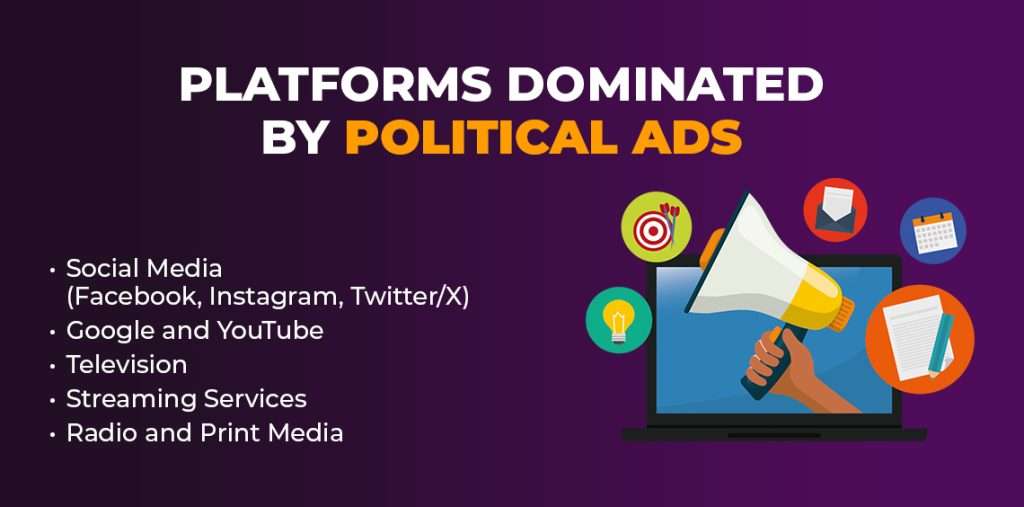
Political ads flood both traditional and digital media spaces, with the most prominent platforms seeing the largest spikes:
- Social Media (Facebook, Instagram, Twitter/X)
Social media platforms are a significant battleground for political ads. These platforms allow for highly targeted advertising, enabling campaigns to reach specific demographics based on location, age, interests, and even political affiliation. For instance, during U.S. elections, platforms like Facebook and Instagram are deluged with political content due to their massive user bases and microtargeting capabilities.
- Google and YouTube
Search engines and video-sharing platforms see heavy political ad spend. Google Ads enables political campaigns to place search and display ads across its network, reaching users when they search for political news or related topics. Meanwhile, YouTube is often used for long-form video ads or viral content, allowing campaigns to reach younger and more diverse audiences.
- Television
Though digital advertising has grown tremendously, television remains a cornerstone for political campaigns, especially for older demographics. Political ads dominate prime-time slots on cable and network television during election cycles, often displacing regular commercial advertisers.
- Streaming Services
With the rise of connected TV (CTV) and streaming services like Hulu, political ads have found their way into on-demand content. These ads offer campaigns another way to reach users who have cut the cord from traditional TV.
- Radio and Print Media
Although radio and print are less prominent than they used to be, they remain part of the mix for reaching specific audiences, particularly in local or regional elections. Political campaigns still buy up ad space in newspapers and on radio stations to influence older or rural voters.
In all of these spaces, political ads tend to outbid or overshadow regular commercial advertising, pushing up prices and crowding out non-political messages. This flood can be so overwhelming that businesses struggle to maintain visibility during critical times for their own marketing campaigns.
Note: Discover proven strategies to grow your luxury brand using Google Search Ads. Check out our guide on scaling with Google Ads here.
How Political Advertising on Social Media Impacts Businesses
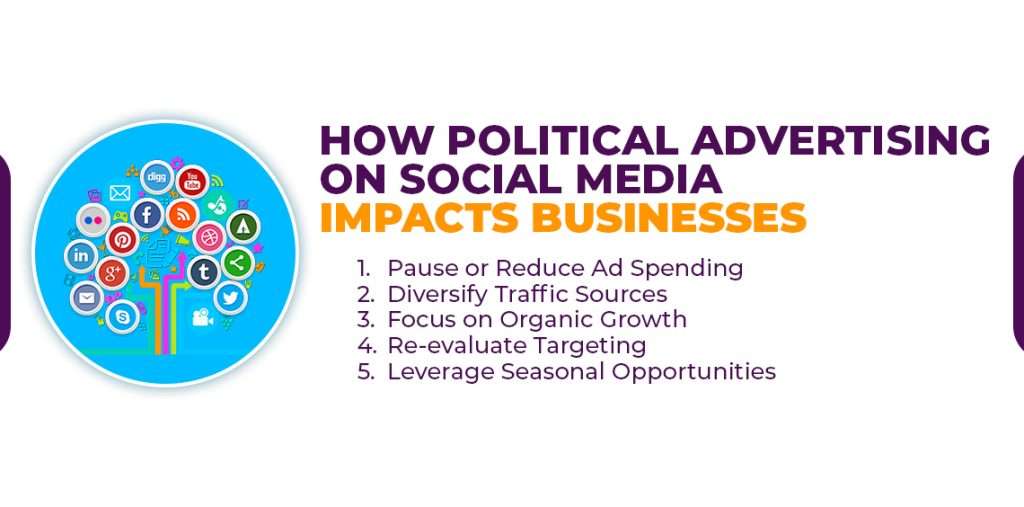
Rising Costs and Competition
- Impact of Political Ads: Political campaigns are driving up social media advertising costs by significantly increasing their spending. This spike in demand for ad space directly affects businesses trying to advertise on the same platforms.
- Effect on Small and Medium-Sized Businesses: These smaller businesses face a tougher challenge than large corporations, as their advertising budgets and strategies are often less flexible. Political ads with massive budgets make it harder for these businesses to stay competitive.
- Broad Targeting Strategies: Political campaigns typically target a wide audience, such as anyone aged 18 or older. This broad approach often overlaps with the specific demographics that businesses focus on, leading to heightened competition for visibility and higher customer acquisition costs during election seasons.
- Reassessing Strategies: Businesses are forced to reconsider their advertising strategies in light of this aggressive political ad spending. They may need to adjust their targeting and budget allocations to maintain effectiveness during election cycles.
Targeting Challenges
- Broad vs. Specific Targeting: The broad targeting of political ads reduces the impact of businesses’ more specific marketing efforts. As political campaigns blanket the platforms with generalized messaging, it becomes increasingly difficult for businesses to reach their precise target audiences.
- Ad Visibility: Since political campaigns often have larger advertising budgets, social media platforms may prioritize their ads. This results in regular business ads being pushed further down in user feeds, reducing their visibility and overall effectiveness.
- Maintaining Precision: To counter these challenges, businesses must work to maintain precise targeting despite the rising costs. This may involve refining their audience segments or exploring alternative platforms to ensure they continue to reach their intended audience effectively.
What are the Strategies to Mitigate the Impact Posed by Political ads?
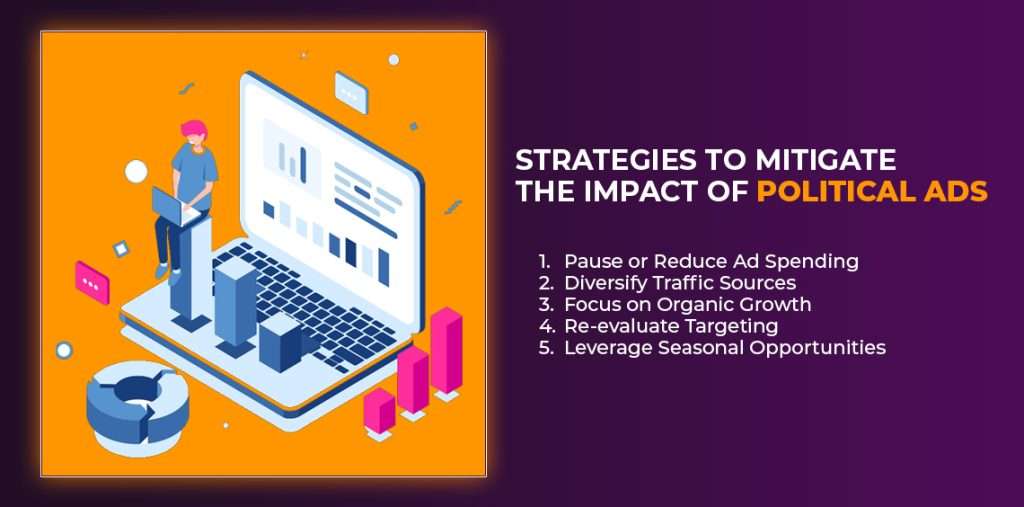
To address the challenges posed by political ad saturation, businesses can implement the following strategies:
Pause or Reduce Ad Spending
- Avoid Direct Competition: Temporarily scaling back advertising can help businesses avoid direct competition with high-budget political ads.
- Efficient Budget Allocation: Reducing spending allows companies to allocate marketing budgets more efficiently, potentially saving funds for post-election advertising when costs normalize.
Diversify Traffic Sources
- Explore Alternative Channels: Instead of relying solely on social media, businesses can utilize other channels like SEO, email marketing, content marketing, and influencer partnerships.
- Reduced Dependence: Diversifying traffic sources can lessen the impact of political ads and uncover new, potentially more cost-effective ways to reach audiences.
Focus on Organic Growth
- Invest in Content and Engagement: Businesses can prioritize creating high-quality content and engaging with audiences to build a sustainable online presence without heavy reliance on paid ads.
- Long-Term Benefits: Organic growth strategies can yield long-term advantages and foster valuable customer relationships, enhancing visibility during ad surges.
Re-evaluate Targeting
- Analyze Audience Segments: Businesses should examine their current audience segments to identify overlaps with political ad targeting and refine their criteria to reach more relevant users.
- Niche Targeting: Exploring niche markets that political campaigns may overlook can enhance ad effectiveness and reduce competition.
Maximize Seasonal Opportunities
- Align Marketing with Holidays: Businesses can focus on marketing during high consumer engagement periods (e.g., Black Friday, Christmas) that coincide with election seasons.
- Maximize Returns: Redirecting ad spend to capitalize on these shopping periods can yield better returns than competing directly with political ads.
The overarching theme of your content emphasizes the challenges businesses face during election seasons due to the influx of political advertising. By adopting strategic approaches, businesses can mitigate the impact of rising costs and competition, maintaining their visibility and effectiveness in a crowded digital advertising landscape.
Frequently Asked Questions for Political Ad Flood
How are political ads affecting social media advertising costs for businesses?
Political ads are flooding social media platforms, targeting a broad audience and spending billions. This surge in ad spending is likely driving up advertising costs for businesses, potentially making customer acquisition more expensive during the election season.
What challenges do businesses face in targeting during political ad seasons?
Businesses face increased ad costs and competition during political seasons. With politicians targeting broad audiences, ad space becomes crowded, driving up prices. This can make it challenging for companies to reach their specific customer base efficiently and cost-effectively, potentially impacting their marketing ROI.
When should businesses consider reducing their social media ad spend?
Businesses should consider reducing social media ad spend during major political events like elections. High competition from political campaigns can inflate costs and dilute ad effectiveness. It’s wise to reallocate budgets to other marketing channels or save for high-impact seasons like Black Friday.
What alternative marketing strategies can businesses use during political campaigns?
Businesses can focus on content marketing, email campaigns, influencer partnerships, and organic social media engagement during political campaigns. These strategies can help maintain brand visibility and customer relationships without competing directly with high-cost political advertising on paid social platforms.
How can businesses optimize their ad spend around Black Friday and Christmas?
Businesses can optimize ad spend for Black Friday and Christmas by focusing on targeted campaigns, utilizing retargeting strategies, and creating compelling holiday-specific offers. Timing is crucial; start early but intensify efforts closer to shopping dates. Monitor performance metrics closely and adjust bids and budgets accordingly to maximize ROI during these peak shopping seasons.
How do social media platform policies affect businesses during election periods?
Social media platform policies can significantly impact businesses by allowing political ads to be microtargeted with fewer restrictions. This means political campaigns can flood users’ feeds with targeted, emotionally charged ads, overshadowing commercial content.
Why is there a disparity in how platforms like Facebook and Google handle political ads?
Facebook allows more freedom in microtargeting political ads, while Google imposes certain limitations. This difference creates an environment where political ads can dominate user feeds on Facebook, leading to higher engagement for these ads compared to commercial content.
Conclusion : Political Ad Flood
The political ad flood during election seasons significantly impacts businesses’ social media advertising strategies, driving up costs and increasing competition for ad space. Small and medium-sized companies face particular challenges as they compete with well-funded political campaigns for user attention.
To mitigate these effects, businesses can adopt strategies such as pausing or reducing ad spend, diversifying traffic sources, focusing on organic growth, re-evaluating targeting, and leveraging seasonal opportunities.
By adapting their approach, companies can maintain their online presence and marketing effectiveness while navigating the challenges posed by the surge in political advertising.
Keep your ads visible, even during election seasons. Partner with Ellington Technologies to outsmart political ad competition and boost your ROI.


